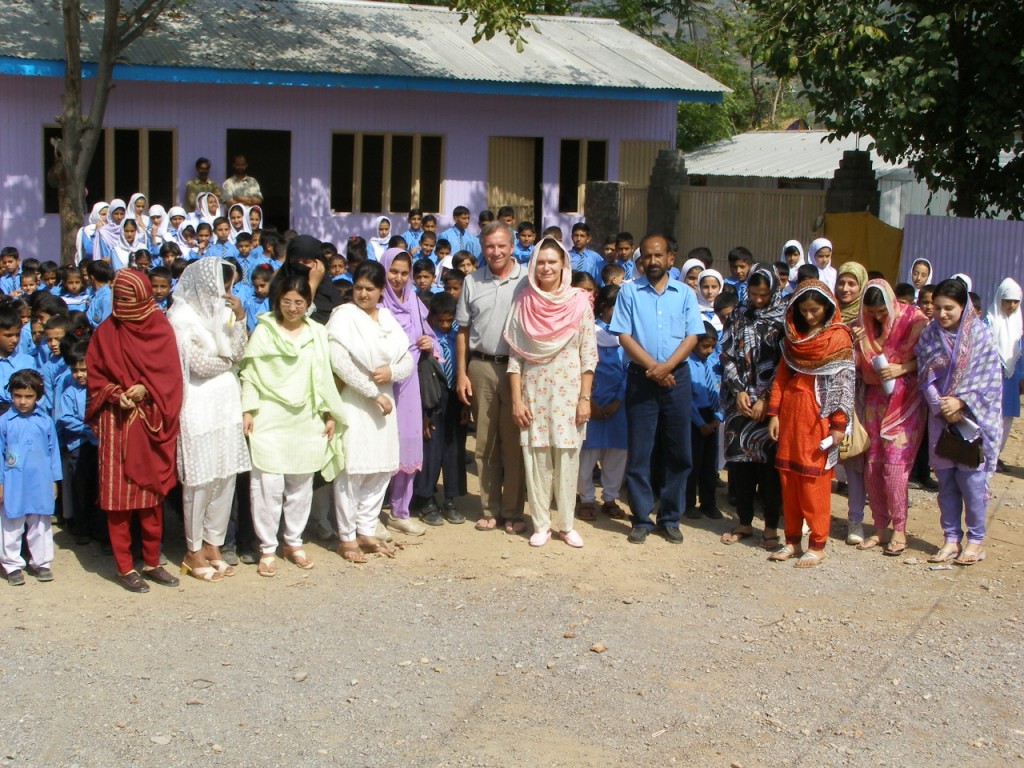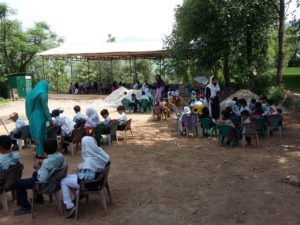An American Woman in Kashmir
An American Woman in Kashmir
A Bad Husband?
It’s mid September, 2006, and in the first week of October I will travel to Pakistan occupied Kashmir (known officially as Azad Jammu and Kashmir or, simply, AJK). I’ve raised money for the victims of the October 8, 2005 earthquake and at last, nearly one year later, the Pakistani/Kashmiri political climate has calmed down enough so I can go there to distribute it.
I want to make sure donations are actually delivered to deserving people and can only be sure that will happen if I am the one to personally hand them out. This means my efforts are hands-on, with regular trips half way around the world.
But this time, as I prepare to pay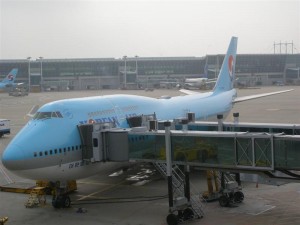 for airfare, something grips me and I tell my wife Linda there is something on my mind and I want to lay it out for her in a pragmatic way, without sounding like I have something to sell. I am thinking she should consider accompanying me. As usual, Kashmir Family Aid will pay none of the travel costs: I will pay all expenses, airfare and otherwise, out of my own pocket. We will leave in two weeks. I tell her we would be in Muzaffarabad, the capital of AJK and the epicenter of the quake, for the one year anniversary ceremonies on October 8th. President Musharraf will speak. Then we would spend a week in the region personally distributing the $20,000 I had raised. The money would go to widows, destitute women and schools in Muzaffarabad and in remote areas.
for airfare, something grips me and I tell my wife Linda there is something on my mind and I want to lay it out for her in a pragmatic way, without sounding like I have something to sell. I am thinking she should consider accompanying me. As usual, Kashmir Family Aid will pay none of the travel costs: I will pay all expenses, airfare and otherwise, out of my own pocket. We will leave in two weeks. I tell her we would be in Muzaffarabad, the capital of AJK and the epicenter of the quake, for the one year anniversary ceremonies on October 8th. President Musharraf will speak. Then we would spend a week in the region personally distributing the $20,000 I had raised. The money would go to widows, destitute women and schools in Muzaffarabad and in remote areas.
I tell her I don’t expect her to go but should at least give her the option. And then I ask myself: If she decides to go due to my encouragement, does that make me a bad husband, a husband too cavalier about the welfare of his wife?
Beyond the Hell of the quake’s immediate devastation and the wicked aftershocks, Pakistan and Azad Kashmir are 98% Muslim and for a westerner of Judeo-Christian descent, a powerful argument could be made that it is not a good place to visit. There are Jihad training camps throughout the region. There is the Pakistan/India border dispute; what Bill Clinton called the most dangerous border conflict in the world. Pakistan, India and China are all involved and each is a nuclear power. Stories of male dominance and female subservience emanate from that side of the world, twelve time zones removed from America’s west coast. By any gauge, Pakistan and AJK are not tourist destinations for westerners. Linda knows this as she’s watched me go back and forth.
But I tell her it is the opportunity of a lifetime and if she goes there she will never be the same. With a neutral demeanor, I say that, yes, there are risks but that I will be there with her and we will be with my Pakistani and Kashmiri friends who will watch over us. And unlike last time when I was shadowed by two Pakistani Intelligence agents, I have made political friends and we will carry around a certain immunity.
And, an upside: she should know that there are women in Kashmir whom we will help who have never laid eyes on a western woman; that there will be silent yet powerful woman-to-woman bonds made despite the cultural and language barriers. And I tell her the children will do nothing less than steal your heart. Trust me, I tell her.
I’ve been to Pakistan five times and to AJK twice and feel comfortable there. But Linda had never been to a third world country, much less a Muslim country that is an intimate player in the War on Terror.
At my proposal her first reaction was a 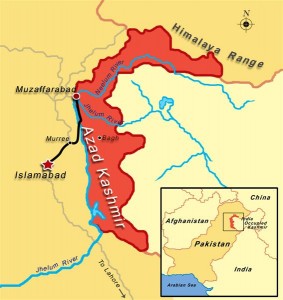 predictable trepidation. Her misgivings about going there were understandable as she watches the news, and like most of us, she seriously considers the one-on-one viewpoints of friends and family (all of whom were aghast). But she knows most Americans fumble at even finding Pakistan and AJK on a world map and therefore they couldn’t possibly accurately relay the on-the-ground reality of these places. So after emotionally wavering back and forth, she courageously over-rode the unanimous veto of those around her and on October 4th found herself beside me on a 747 headed to Taipei, to Bangkok and then to Lahore, Pakistan. We would be gone for 14 days and in that time we would spend several days deep in the heart of rural AJK, in places where no westerners had ever been before.
predictable trepidation. Her misgivings about going there were understandable as she watches the news, and like most of us, she seriously considers the one-on-one viewpoints of friends and family (all of whom were aghast). But she knows most Americans fumble at even finding Pakistan and AJK on a world map and therefore they couldn’t possibly accurately relay the on-the-ground reality of these places. So after emotionally wavering back and forth, she courageously over-rode the unanimous veto of those around her and on October 4th found herself beside me on a 747 headed to Taipei, to Bangkok and then to Lahore, Pakistan. We would be gone for 14 days and in that time we would spend several days deep in the heart of rural AJK, in places where no westerners had ever been before.
In my own defense as a good husband, and notwithstanding my low-key sales pitch, it is Linda’s decision to go. I never goaded her.
Enduring Planet Earth’s Maximum Possible Jet Lag.
It has been 36 hours of travel over twelve time zones – we’re literally on the other side of the world – and my wealthy Pakistani friends Ahsan and Mina are waiting for us at the chaotic Lahore airport. It’s the middle of the night here (and the middle of the day in Oregon) and in our travel-stupor they whisk us off to the spacious home of Ahsan’s sister Rizwana who will host our stay while in Lahore, our staging ground for the last segment of the journey which would take us into Azad Kashmir. This is where I waylaid on my last trip and Rizwana and I are fast friends. I am anxious for her to meet Linda and know they will like each other.
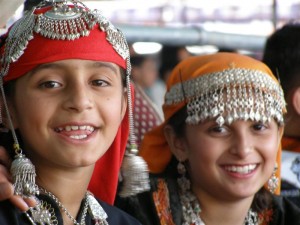 The jet lag will be profound and will hit hard in another 24 hours but for tonight our minds buzz.
The jet lag will be profound and will hit hard in another 24 hours but for tonight our minds buzz.
We restlessly slept for a few hours as our bodies struggled to adjust. Wide awake, we sat up in bed at 3am and talked, amusing ourselves with the thought that if we were to point in the direction of our Bend, Oregon home, our fingers would not be directed east or west but rather, straight down through the middle of the bed.
The house has a half dozen servants and our early morning breakfast and tea is perfect, served to us, literally, on a silver platter. The tea of Pakistan is unmatched, in contrast to the instant coffee which is the worst I have ever endured. So, in the mornings here, it is black tea, rich with cream and sugar…
We know that the worst of the jet lag will be days two through six and we’ll tend toward dull, grouchy, flaky. Our hosts understand our detached demeanor as we settle in for a morning of rest at their huge house, gated and guarded from the third world street-chaos that churns outside. Later in the morning we’ll venture out. There is shopping that must be done before the next day’s long journey into AJK.
Dressing the Part
It is mid-day on this first day in third world Pakistan and the streets of Lahore are semi-controlled mayhem. There are beggars everywhere; the air pollution is thick. The traffic is insane and as we weave through the city in Ahsan’s tiny Chinese car we spot the obligatory “Death to Israel” and “Hate America” graffiti. We are out of the car and in the street now. Linda is dressed in western garb and there is no male who can take his eyes off her. The depression of the jet lag is encroaching and Linda is not amused
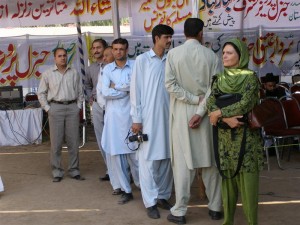 In contrast to the hit and run political graffiti, as guests, Linda and I are treated like gold as we prepare for our trip into Muzaffarabad. Linda buys fabric and has three Salwar Kameez outfits tailor-made on the spot. The Salwar Kameez is the traditional Pakistani woman’s cotton three piece garb and not wearing it is an invitation for outright disapproval. She immediately donned one of the modest outfits and the male attention decreased. My apparel stayed western. As a male it was not big deal in this westernizing city, but I had two sets of Salwar Kameez ready to go for the trip into AJK. In the backcountry, the garb would be mandatory if I didn’t want to stand out as a clown, or worse.
In contrast to the hit and run political graffiti, as guests, Linda and I are treated like gold as we prepare for our trip into Muzaffarabad. Linda buys fabric and has three Salwar Kameez outfits tailor-made on the spot. The Salwar Kameez is the traditional Pakistani woman’s cotton three piece garb and not wearing it is an invitation for outright disapproval. She immediately donned one of the modest outfits and the male attention decreased. My apparel stayed western. As a male it was not big deal in this westernizing city, but I had two sets of Salwar Kameez ready to go for the trip into AJK. In the backcountry, the garb would be mandatory if I didn’t want to stand out as a clown, or worse.
So we spent one day in Lahore prepared to head north to AJK the next day. The first step would be a short flight to Islamabad on Pakistani Airways and the second step, a tortuous, nail-biting four hour auto-quest through the mountains.
The Quake Zone: November 2005
My first visit to Azad Kashmir was eleven months before, just after the October 8th quake. When I heard about the devastation, I tied up loose ends and jumped on a plane. I went solo. For three weeks I lived in the middle of it all, at the quake epicenter in Muzaffarabad. There was the rubble of collapsed buildings everywhere; survivors dumbfounded, hungry and cold with no where to live; the city a cauldron of chaos. Wild eyes betrayed the hard-wired emotional imprint of the indescribable violence of the quake; the shell-shock compounded by the death of loved ones, many still buried in the rubble. In the quake zone, nearly everyone lost someone close yet no one had the time or resources to mourn the dead because the immediate aftermath included five nights with no electricity; masses of people huddled in the streets in order to escape being crushed from still-collapsing buildings. For survivors, it was pitch blackness and cold rain, out in the open, with no food or water.
An estimated 80,000 lost their lives 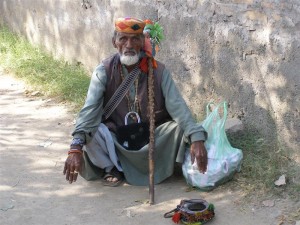 throughout the 30,000 square mile affected area of Northern Pakistan, AJK and India, with twice that many seriously injured to the point of amputation or permanent paralysis. Four million people were left homeless.
throughout the 30,000 square mile affected area of Northern Pakistan, AJK and India, with twice that many seriously injured to the point of amputation or permanent paralysis. Four million people were left homeless.
The horrific 7.6 magnitude quake struck at 8:52am on a Saturday, a school day, and an out-of-proportion percentage of the fatalities were school children who had just settled into their desks. The construction of walls of the schools and homes was with non-reinforced mortar and stone. They crumbled instantly. The one-foot thick concrete roofs were reinforced though, and in slabs, they came straight down.
1,600 schools were completely destroyed. 500 were partially damaged.
Many of the school-age survivors, emotional traumatized, were labeled “affected children,” as they walked about the tent camps dazed and silent. There was emptiness in their eyes. How could the earth below them gyrate so madly? Would another quake come tonight or tomorrow? A large percentage of them are orphans.
Alone for three weeks, I prowled the streets of Muzaffarabad, at night staying with my new-found Kashmiri friends in a house in a section of the city that was less wrecked. There were cracks in the walls but the house was still standing. I was the only westerner on the streets – the rest holed up in their armed-guarded NGO enclaves, treating the wounded as they stumbled in. For the Kashmiris on the street, the consensus was that the outside world performed a magnificent job, and that the United States was in the forefront of it all. From Mash medical units to Chinook helicopters to bulldozers to engineering expertise to emergency food and water deliveries, things were being handled well. I saw this and was proud to be an American.
I hired a car and driver and we traveled over remote roads to Balacot in the Pakistan’s North-West Frontier Province. The devastation there was worse than in Muzaffarabad. The crowning horror was a collapsed school with 250 elementary students still inside, yet to be recovered and properly buried. The Pakistani army had just begun this chore, digging in underneath one end of the long, narrow building’s perfectly preserved roof, the concrete slab one foot thick and over 200 feet long and 40 feet wide, now inches from the ground, everything underneath crushed. Not one child survived.
As an amateur journalist, I wrote ten articles in those three weeks. In that time I began to envision a permanent non-profit organization, dedicated to assisting the children and woman survivors of the quake. The added twist was that this is a training ground for Islamic jihad; the Madrassa schools and camps that produce legions of non-uniformed soldiers bent on eliminating western ways if not the west altogether.
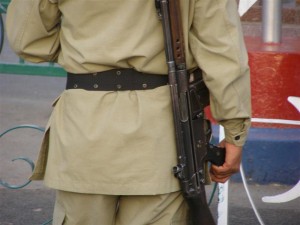 After four weeks I returned to my home in Bend, Oregon, set some goals, created a website, and over the winter raised $20,000 by making Power Point slide presentations and hounding my friends and colleagues for donations. My Spring trip back to AJK to distribute the money was delayed repeatedly by the serial political unrest of Pakistan and throughout the Muslim world….the Cartoon Riots, The American military’s killing of the number two Al Qaeda man within sovereign Pakistan, the Mumbai bombings, the Pope’s thoughts about the prophet Mohammad… Now, finally, in September of 2006 there was a gap in chaos and it was time to go back.
After four weeks I returned to my home in Bend, Oregon, set some goals, created a website, and over the winter raised $20,000 by making Power Point slide presentations and hounding my friends and colleagues for donations. My Spring trip back to AJK to distribute the money was delayed repeatedly by the serial political unrest of Pakistan and throughout the Muslim world….the Cartoon Riots, The American military’s killing of the number two Al Qaeda man within sovereign Pakistan, the Mumbai bombings, the Pope’s thoughts about the prophet Mohammad… Now, finally, in September of 2006 there was a gap in chaos and it was time to go back.
And this time Linda would go back there with me. My guess was that her strong German comportment would see her through. My Pakistani and Kashmiri friends and I would be there every moment.
The Waste of Energy that is Ranting
There is a conundrum that is important to acknowledge. Most of us think a change in how our governments operate will win the war on terror. What other options do we have except to hope that those in power will solve these problems? And as we watch world events unfold, most of us feel helpless to make things better. So the crux of our personal frustration and anger is that we want to see the violence stop but think there is nothing we can do except complain. In the long term, political leadership changes will make little difference: half our population sees things one way and the other half sees things differently and the fundamental ideological struggle will continue. In any case, Islamic radicals don’t care one way or the other. They will continue to come after us.
Our own national divisiveness has become our largest liability as we emotionally thrash about, laying blame and wishing something would change. But isn’t it true that the root cure for finding peace will lie in undergoing change in individual perception, you and me; us and them?
The governments of our world finger-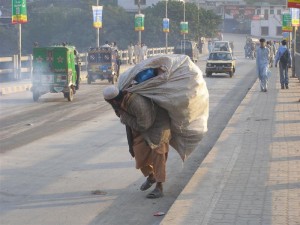 point. They blame and they make excuses and sometimes they are stupid and callus but other times they do brilliant work and are selfless. In defense of our various leaders over the generations it must be asked, how can one measure the catastrophes that have NOT happened because of top-level negotiations and covert intrigues? Militaries make offensive moves and they make defensive moves. And regarding all that, in our everyday real worlds, what does it really matter what any of us thinks of George Bush, or of Bill and/or Hillary Clinton? Or of Kim Jong Il or Sadam Hussain or what goes on in Guantanamo or in Iraq or in Afghanistan? And, if we must take all this personally, what really can we do about any of it? Is there some way any one individual can affect an outcome by simply ranting about the other side?
point. They blame and they make excuses and sometimes they are stupid and callus but other times they do brilliant work and are selfless. In defense of our various leaders over the generations it must be asked, how can one measure the catastrophes that have NOT happened because of top-level negotiations and covert intrigues? Militaries make offensive moves and they make defensive moves. And regarding all that, in our everyday real worlds, what does it really matter what any of us thinks of George Bush, or of Bill and/or Hillary Clinton? Or of Kim Jong Il or Sadam Hussain or what goes on in Guantanamo or in Iraq or in Afghanistan? And, if we must take all this personally, what really can we do about any of it? Is there some way any one individual can affect an outcome by simply ranting about the other side?
No.
Yes, we can pay our taxes and yes that money goes to various necessary places including funding the military and in supporting our schools, the roads, the police. But at the risk of oversimplification, and speaking of our most pressing problem – the war on terror and the struggle for understanding between East and West – complaining and voting every couple of years won’t make all that much difference. The reason is because what we have is a simple misunderstanding between cultures.
If simple understanding within the masses could happen, the extremists on both sides would be suppressed. The masses would see to that.
Carry this with you as you read on: Linda and spent one week in the middle of Azad Kashmir, a Muslim population in which 99% have never before spoken to a westerner. In that week, it is my estimate that we directly or indirectly affected a minimum of 10,000 people, virtually all of whom had a previously inaccurate view of who we are as westerners. We delivered a message of peace and caring without asking anything in return. Nothing more. Nothing less.
Take a chance here. Read on and consider a new approach. Consider personal energy expenditure in a way that makes a difference and in a way that gives personal satisfaction rather than anger and frustration. For any one of us taking action in this way, it’s a matter of geometric progression; a bit of positive effort here causing a huge positive impact out there. No more ranting or defending positions. No more sticking heads in the sand. No more impotence. What I am proposing is tangible. It’s a grass roots something-you-can-do with enormous and immediate positive affects. This is about your personal imprint in improving East-West relations as well as helping real people in need. Linda and I know it can be done. We just accomplished some of that. For us, there will be no more ranting. How about you?
October 7, 2006: Reentering Muzaffarabad
It is time to head for AJK and we fly north. It’s a short 35 minute flight and at the Islamabad airport, my Muzaffarabad contact, Khizar Abbasi, is at the gate waiting. A good man, Khizar, I am personally paying him a small monthly salary to carefully select the people who will receive aid from our organization. Previously a correspondent for the Pakistani Geo TV network, and therefore an investigator at heart – perfect for this job – Khizar and his family are also victims of the quake.
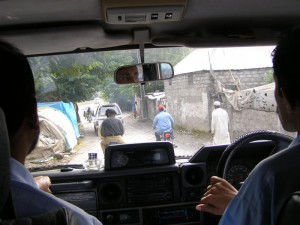 Khizar has a driver and a Land Rover and the four of us are ready to head for Muzaffarabad but we are now in Islamabad, the capital city of Pakistan, and we must first secure the official Pakistan No Objection Certificate. One can’t enter AJK unless one has a good reason to do so and at the Pakistan/AJK border there are roadblocks with Pakistani soldiers to enforce the policy. For this reason the place is mysterious to westerners (and, as westerners, we will be celebrities when we get there). With Khizar’s lead, we’ve been working on NOC approval for weeks and we wait in the nondescript office of the government official who makes the final decision. Tahira is gracious as she questions our intentions and then willingly gives us the NOC based on my journalism credentials, our humanitarian efforts and, no small thing, Linda’s elegant, Salwar Kameezed presence.
Khizar has a driver and a Land Rover and the four of us are ready to head for Muzaffarabad but we are now in Islamabad, the capital city of Pakistan, and we must first secure the official Pakistan No Objection Certificate. One can’t enter AJK unless one has a good reason to do so and at the Pakistan/AJK border there are roadblocks with Pakistani soldiers to enforce the policy. For this reason the place is mysterious to westerners (and, as westerners, we will be celebrities when we get there). With Khizar’s lead, we’ve been working on NOC approval for weeks and we wait in the nondescript office of the government official who makes the final decision. Tahira is gracious as she questions our intentions and then willingly gives us the NOC based on my journalism credentials, our humanitarian efforts and, no small thing, Linda’s elegant, Salwar Kameezed presence.
We drive east, out of Islamabad and into the back country.
It’s a torturous four hour drive up and over a 6,000 foot pass and along the rampaging Jellum River, the gyrating road dotted with villages that are overflowing with cars, trucks, motorbikes, donkey carts and pedestrians. We finally enter Muzaffarabad, the capital city of AJK. Linda and I are emotional and physical wrecks, the fatigue of the day’s travel compounded by the excruciating jet lag which has finally descended upon us in full force. We’re disjointed and flaky.
The city’s devastation of one year before is still in-your-face evident despite the cleanup that has removed 75% of the rubble that used to be homes and schools. There are hoards of people everywhere in the downtown area but in contrast to my previous visit just after the quake, the eyes of these people are no longer wild and glassy, but are focused and deliberate. There is commerce again, with row after row of stalls and their vendors.
The winding street, through the middle of this bustling wreck of a city, sometimes with the non-barricaded shoulders abruptly falling away into the river below, is jam packed with every conceivable mode of conveyance, all careening too fast, the Salwar Kameezed pedestrians dodging and weaving through the traffic. The remaining buildings cram themselves up against the narrow street, cracked and shattered but inhabited nonetheless.
It’s a madhouse and that invisible third-world buzz is pervasive. Despite the devastation and chaos, and our own travel-weariness, we feel sheer energy emanating from everywhere. Life goes on and the human condition is a miraculous thing. We smile.
We spend the first night in the home of Noreen Arif and her husband Dr. Raja Muhammad Arif, both Assembly members of the AJK government. Mrs. Arif is the first elected woman in the Parliament. Her daughter is married to the former Prime Minister’s son. These are important people and it is an honor to stay with them in their guest room.
We slept fitfully at first but then talked 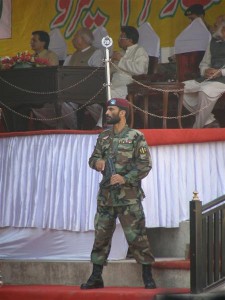 through much of the night knowing that October 8th was upon us, the one-year anniversary of the quake. Khizar and the driver arrived early and we traveled across town to where the university used to stand, now an empty, dusty field covered with an enormous open tent filled with thousands of Pakistanis and Kashmiris. President Musharraf would speak. There were machine-gunned guards everywhere, awaiting the arrival of his helicopter. At first, the military officials denied our admittance as our paperwork was not to their liking but Khizar pulled strings and we got in at the last minute, sitting in the press section near the stage. We were the only westerners there. 99% of the crowd was male.
through much of the night knowing that October 8th was upon us, the one-year anniversary of the quake. Khizar and the driver arrived early and we traveled across town to where the university used to stand, now an empty, dusty field covered with an enormous open tent filled with thousands of Pakistanis and Kashmiris. President Musharraf would speak. There were machine-gunned guards everywhere, awaiting the arrival of his helicopter. At first, the military officials denied our admittance as our paperwork was not to their liking but Khizar pulled strings and we got in at the last minute, sitting in the press section near the stage. We were the only westerners there. 99% of the crowd was male.
The preliminaries included the male hoard’s raucous chants of “Pahk-ee-Stan! Pahk-ee-stan! Pahk-ee-stahn!”
Over and over the testosterone-propelled incantation continued, a multitude of fists repeatedly jammed into the air in passionate, perfect unison.
Musharraf arrived. He sat on the stage, western-bespectacled in aviator sunglasses, just days returned from his Washington visit with President Bush and Afghanistan President Karsai. He spoke in Urdu and we understood none of it. We got the point though and at 8:52am there was silence as the exact moment of the quake was acknowledged; the people who died remembered.
Tent Camps
It’s day two in Muzaffarabad. By foot, we tentatively trace our way through a tent camp, one of many within the city. One year after the quake, the camps still hold 40,000 Kashmiris who have no other place to live. The tents are old, beaten and rotted by last winter’s snowfall and then baked in the recent summer’s torturous heat. Avoiding tripping over the tent pegs and stepping in the filth, Linda, Khizar and I poke through the mud among the tents. Children hover around, curious and hoping for a chocolate handout. The adults watch passively, not knowing and probably not caring why we are there. It is Linda’s first brush with the worst of it all.
Immediately after the quake one year ago, their homes flattened in their remote villages high in the surrounding hills and mountains, these people retreated to the relatively low elevation Muzaffarabad and the center of quake relief efforts. They lost everything and still don’t have enough resources to go back to their villages to rebuild. Based on the number of injured and dead in a family, the Pakistani government has a formula for doling out money to victims. In the worst cases their homes and small plots of land, which typically have been in the family for many generations, are gone altogether, swept away or altogether swallowed up by the quake.
So far, most landowners have 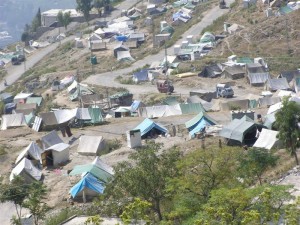 received just the first of three promised payments from the Pakistani government. These first allotments have been 25,000 Rupees, approximately $400 U.S. dollars, hardly enough to build a new home or purchase new land. The people who did not own their land – squatters – are the ultimate casualties, receiving no government stipend whatsoever.
received just the first of three promised payments from the Pakistani government. These first allotments have been 25,000 Rupees, approximately $400 U.S. dollars, hardly enough to build a new home or purchase new land. The people who did not own their land – squatters – are the ultimate casualties, receiving no government stipend whatsoever.
Now the families are facing their second winter in the donated tents. Most of the original tent dwellers have returned to their villages to rebuild their lives but these tens of thousands remain, six to twelve people in 150 square foot tents.
Students
Tents and ad-hoc corrugated galvanized iron (CGI) shelters compose the classrooms of the largest public school in Muzaffarabad. There are over 900 students here, grades one through ten. The students sit in the heat in their uniforms and when we enter their ad-hoc tent classrooms with their principal, they stand in unison, greeting us with a perfectly synchronized “Welcome to our school!” They have been carefully prepped for our arrival.
The girls wear brightly colored Salwar Kameez, highlighted with a perfectly white dupatta scarf; Each little boy has white shirt, dark blue tie, and neat trousers.
There are two toilets for these 900 students. The tents are a year old now, ragged and ripped as they rot. Other classrooms, tin shelters which are 30 foot sections of huge culvert pipe, are altogether open on each end.
Many of the students in the lower grades have no shelter at all and sit on the ground.
On this October day the tents and culvert huts are piping hot. Soon, freezing weather will descend and the students will continue to sit there in plastic chairs – or on the ground – and attempt of focus on their studies while they ward off the cold. There is no playground or athletic field.
Most of these children have lost a parent or brother or sister in the quake. A large percentage are orphans.
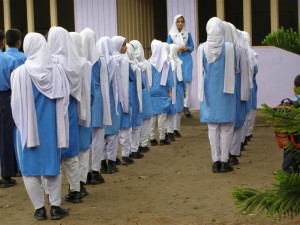 In a smaller private school, the children stand there in straight-line rigid formation, uniformed, with cautious smiles on their faces, delighted to shake hands and to chat in their tentative English, the historical British influence evident in their all-for-one, one-for-all formality. Their collective, “I’m proud to be a part of this group” demeanor is refreshing in contrast to the semi free-for-all personas of schools back home in the U.S. where teachers are so anxious to promote individuality and so paranoid about the possibility of hurting a child’s feelings. We can’t imagine there could be a disruptive student here; that any child would want to stand out in that way. And it’s not Orwellian group-think: it’s simple respect. Indeed, how refreshing…
In a smaller private school, the children stand there in straight-line rigid formation, uniformed, with cautious smiles on their faces, delighted to shake hands and to chat in their tentative English, the historical British influence evident in their all-for-one, one-for-all formality. Their collective, “I’m proud to be a part of this group” demeanor is refreshing in contrast to the semi free-for-all personas of schools back home in the U.S. where teachers are so anxious to promote individuality and so paranoid about the possibility of hurting a child’s feelings. We can’t imagine there could be a disruptive student here; that any child would want to stand out in that way. And it’s not Orwellian group-think: it’s simple respect. Indeed, how refreshing…
We enter an actual stick-built classroom and the children immediately stand and in unison, declare a hearty “good morning!” We ask the children to sit. Some ask questions; others are too frozen with nervousness to utter a word, enthralled at the presence of Westerners. At recess outside, they swarm about us, the girls enclosing Linda to touch her; to ask questions; to garner some small bit of attention. The boys surround me, testing their firm handshakes and asking about America, using their classroom-learned English in the real world with a for-real American. It’s a madhouse, really, the children beside themselves with glee.
In several of the dozens of classes we entered, I asked the older students if they had ever talked to a westerner and only one student said he had: He had met two, in fact, a German and a Russian. It’s my guess that not one of the three hundred students had ever met an American.
I love Azad Kashmir, and at home in the States when so often I yearn to go back, it’s the memory of these children that haunts me.
The curriculums of these schools vary 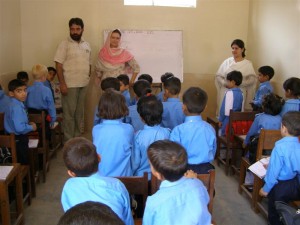 with a wide distinction between public/private schools and Madrassas. The private schools, maybe 40% of the total, have always taught English from the first grade. The public schools, the schools in which the less affluent attend, have traditionally taught English beginning in the 6th grade. President Musharraf changed that in the past year and public schools now also teach English beginning in the first grade. Madrassas teach no English, no math and no science but focus only on Islamic teachings and philosophy. Many Madrassas are financed by Saudi Arabia and some of these particular schools are incubators of jihad.
with a wide distinction between public/private schools and Madrassas. The private schools, maybe 40% of the total, have always taught English from the first grade. The public schools, the schools in which the less affluent attend, have traditionally taught English beginning in the 6th grade. President Musharraf changed that in the past year and public schools now also teach English beginning in the first grade. Madrassas teach no English, no math and no science but focus only on Islamic teachings and philosophy. Many Madrassas are financed by Saudi Arabia and some of these particular schools are incubators of jihad.
Back Pay to Teachers
The private school that intrigues us is under construction, half built, with the children being taught in the partially completed classrooms. There are workers all around. The construction is of light steel framing and corrugated CGI panels with one inch foam-board insulation to ward off the winter cold and the summer heat. With eight of the projected sixteen classrooms constructed, the Administrator, Tanveer Muhammad, tells us construction will stop the next day as his supporting foundation has run out of money.
The school teaches children ages 5 through 14 many of whom are orphans who attend for no charge. Others are sponsored by charitable individuals or groups. For this private school, the standard monthly tuition for those who can pay is $16.00 per month in contrast to public school tuition which is $2.00 per month.
For their morning assembly, they stand outside in perfectly straight lines in their clean uniforms, avoiding the mud holes at their feet. Linda and I wonder at how the bright colored uniforms can remain so crisp and clean.
Tanveer tells us of his plans for completing construction and it immediately strikes us that at a building cost of just $6.00 per square foot, this is a project that we could take on with a single corporate sponsor back in the United States: The entire school operates at a cost of less than $1,000 per month. But, Tanveer tells us there is a more immediate problem than the halt in the construction: The staff of 13 teachers, all but one female, have not been paid for two months. Tanveer’s wife, the school Principal, tells us that Eid, the end of Ramadon and the ultimate Muslim celebration of the year, is coming within two weeks and the teachers have no money to buy new shoes or clothes for their children. For these teachers and their families the celebration will be humiliating and sad.
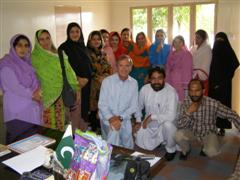 That night we eat dinner at the Tanveer’s rented house, his wife serving the food. He tells us his salary is 10,000 Rupees per month which is $165 in U.S. funds. His teachers earn half that, or less. We talked. His politics were up-front, a passionate tirade for moderation instead of radicalism. It’s a hazardous, courageous stance for someone in his position.
That night we eat dinner at the Tanveer’s rented house, his wife serving the food. He tells us his salary is 10,000 Rupees per month which is $165 in U.S. funds. His teachers earn half that, or less. We talked. His politics were up-front, a passionate tirade for moderation instead of radicalism. It’s a hazardous, courageous stance for someone in his position.
The next morning Tanveer gave us a written list of immediate cost concerns, with teacher’s back pay the number one priority. That was exactly what we wanted to see – his teachers at the top of the priority list – so later that day we contacted him and told him we would pay the back pay, in cash, in a group meeting.
In one of the small newly constructed rooms we explain to the cluster of teachers that we want their students to have what we Westerners want for our students: the ability to think for themselves and to learn to tolerate people who are different. That’s it, we tell them. That’s all we want.
And we offer an option but only if they think it is something that would be good. Later, when school construction is complete, we can return to equip their school with computers so the students can correspond with students at Highland Elementary school in our home of Bend, Oregon. We are surprised at their enthusiasm: They are beside themselves with joy at that prospect and so we tell them of Susie Lucas, the teacher at Highland who already organized her students to raise money – almost 500,000 Rupees (over $2,800 in U.S. dollars) to help the children of AJK. We explain that the money these American children raised is the money we just gave them to cover their back wages.
The teachers, happy, walked away from the meeting with a slightly perplexed view of these strange westerners. Why did these people from America do this? Could it be that they do it because they just want us to be OK; that they just want our children to be OK? That’s it? Nothing more?
Back Country AJK: Widows and Destitute Women
Day three, we travel south by Land Rover, the non-English speaking driver, Linda, Khizar and me. An hour out of Muzaffarabad, along the gushing Jellum River, we head uphill into the backcountry. Off the pavement now, we gyrate up a steep jeep trail. Up and up, we slowly poke our way until we reach a small home, high above the river. The vastness of the valley below, across and above us is profound. We are still in AJK, just across the river from Pakistan.
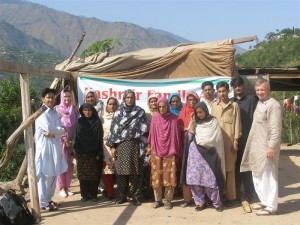 It’s incredibly steep country, rising thousands of feet above us on all sides, and everywhere we look homes perch precariously. With plenty of space between them, thousands of homes are scattered across the vertical and horizontal expanse, each housing the typical Muslim family of six to twelve. Here, many homes were crushed to rubble by the quake, but most still remain, offering some degree of habitability. Eighty five percent of the 3.2 million citizens of AJK live in rural homes like these, spread across the enormous rolling ridges 60 kilometers east and west and several hundred kilometers north and south.
It’s incredibly steep country, rising thousands of feet above us on all sides, and everywhere we look homes perch precariously. With plenty of space between them, thousands of homes are scattered across the vertical and horizontal expanse, each housing the typical Muslim family of six to twelve. Here, many homes were crushed to rubble by the quake, but most still remain, offering some degree of habitability. Eighty five percent of the 3.2 million citizens of AJK live in rural homes like these, spread across the enormous rolling ridges 60 kilometers east and west and several hundred kilometers north and south.
We exit the Land Cruiser and are dwarfed by the vastness surrounding us. We lk silently up to a house. Linda and I are emotionally swallowed up by the enormity of all this, these foothills of the Himalaya-Karakoram mountains that lie just 80 kilometers to the northeast; the carefully placed homes that stretch endlessly in every direction, back and forth, up and down. We meet the owner of the home and are served tea despite the Ramadan fasting that stretches from 5am through 6pm each day.
Eight widowed and destitute women have gathered below the main house, 100 yards distant in a small courtyard just outside a series of small shacks. They are waiting for us. They know we have come to help them.
One at a time, Linda passes the money out to each woman. We take photos so we can take back evidence of what we’ve done to help us raise even more money for a return trip. One by one, the women smile their gratitude at the 10,000 Rupees ($100 in U.S. dollars) placed in their hands. For most, it is a full year’s income. Each embraces Linda, not in the usual western tentative pat-on-the-back way, but in an enduring I-don’t-want-to-let-go clutch.
Unable to read or write, each woman signs an X or inked a thumbprint in Khizar’s record book. We take a group photo. None of these women speaks English but Khizar translates into their native Urdu that Linda and I are from America and that our American friends want them to have this money so they will have some relief from the pain.
They are surprised, but not in shock about receiving these gifts as selfless giving to their families and their neighbors is something each of them has done all their lives. But this is their first encounter with westerners and it is my guess that any second hand negative concepts they might have had about Americans is evaporating absolutely. In our visit, we assist over fifty women, a tiny, tiny fraction of the widows and destitute woman who live in this back country.
Back to Lahore
I will stay on but Linda will return to Lahore this evening. So, descending from the hills, and already part-way back to Islamabad, we brave the remainder of the wild road back to the airport. Then, with Linda safely airborne for the short evening flight to Lahore, the three of us head back to Muzaffarabad, arriving in the wee hours, our heads throbbing with the roller coaster ride and way too much tea. I remain in Muzaffarabad for three more days, working with Khizar to pass out the rest of the donated money and to visit three more schools, two in Muzaffarabad and one in the far reaches of another rural area.
It is still Ramadan. In those last days I fast along with Khizar. In fasting, I feel more a part of things; less of a westerner and more of a Kashmiri. Each day we awake at 4:00am and Khizar’s wife, Nasreen, fixes us Chapati with eggs or lamb stew. Then, as the chanted prayers from the mosques begins just before 5:00am, signifying the beginning of the day’s fast and the emergence of dawn, Khizar and Nasreen go back to bed while I roam the city streets.
Four days later I return to Lahore. That night, Linda and I discuss the reality of things: The enormity of the problems within the quake-devastated Azad Jammu Kashmir. I had spent time in the region before and it is gratifying to hear Linda’s thoughts which echo what has been inside me for this past year. Our sentiments are shared exactly: Going inside and witnessing the reality first-hand is a slap-in-the-face realization that these are flesh and blood people: real people who have fears and dreams and ups and downs. They have families whom they love. They have beliefs which they are passionate about. And their lack of interest in east-west politics is in contrast to their desire for peace within their families and their communities. They want their children to be OK and they want their family names to be passed on to future generations as their own names were passed on to them. Most of all, they want the here and now to be safe; for the fear and hunger to go away.
One could look at the immensity of the problems and ask if what we have done is something less than a drop in the bucket. Or, we can consider the fifty women whom we helped and ask each of them if we had made an impact on their lives. To those women, would it have matter if we had not appeared at all? And we talked to hundreds of students in dozens of classrooms. We told the students of our intentions about raising more money and coming back to help some more, later. We asked them about their hopes and fears. Linda and I talked to hundreds of students, and dozens of teachers, most of whom had never encountered Americans. Did we make a difference?
Something Much More Than the Usual Charitable Contribution
Here it is: The people of AJK need help. They are not getting much from the West right now. The earthquake rubble is nearly cleared, the UN compound is being dismantled, the Chinooks are gone but the poverty and the tents-as-homes and the ad-hoc schools remain. Yes, it’s true that we want to reawaken westerners to the need that is still there. And, yes, Kashmir Family Aid is seeking donations. Yet there is much more to all this and it extends into your own life and the life of your family. It’s about nothing less than the huge positive impact an individual can have.
Here is something real and tangible you can do – in Pakistan and Kashmir – deep inside the heart of jihad. Linda and I did it, and – directly or indirectly – so can you. It is where we must go if we are to make connections with the moderate people who can ultimately stop extremism. Will you make a donation?
What is evident if one travels to the region is that these people know nothing of westerners. They are aware that we helped during the immediate aftermath of the earthquake crisis but they also know that those same Americans and the Europeans went home. In any case, very, very few – I’d say less than one percent – have ever met a westerner and virtually none of them know what our live are like and who we are as people. Our western world is as mysterious to them as their eastern world is to us. And so often, mystery carries an element of fear.
And, how many Kashmiri’s or Pakistani’s do you know? Another question, will the long-term solution to the War on Terror be by governments, guns, politics and forced ideology or will it be by finding common neutral ground: simple understanding between individuals?
In the long-term it’s going to be common one-on-one understanding that solves the problems and to illustrate, understand that Linda and I directly communicated with at least 1,000 people in our one week in AJK. And those 1,000 people have families and friends and it’s my bet that all told, as I said, we had a positive impact on 10,000 Kashmiris. First hand or second hand, each knows we gave and then asked for nothing; That we Americans are real flesh and blood people who hurt and laugh in the same way that they do. THIS is where the war on terror will be won. Not in the Madrassas and not in the bombings and not in the politics. It’s in the classrooms and in the homes, both East and West.
So, Kashmir Family Aid’s mechanical focus is twofold: First, to assist private and public school teachers and their students. And second, to relieve the desperation of widows and destitute women.
Linda will tell you that her first nights in the earthquake region were full of tears at the apparent futility of it all. Ask her now and she will tell you that the people we met there have names and faces and that what we did was significant both for them and for us. She will also tell you that what we did has wider implications, too. Probably wider than we can imagine.
The people on the ground – both in the East and in the West – will ultimately settle things and if you want to be, you can be in the middle of it all. Please consider helping us out.
